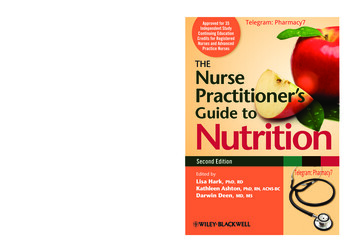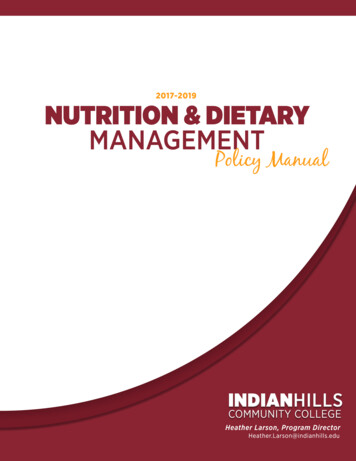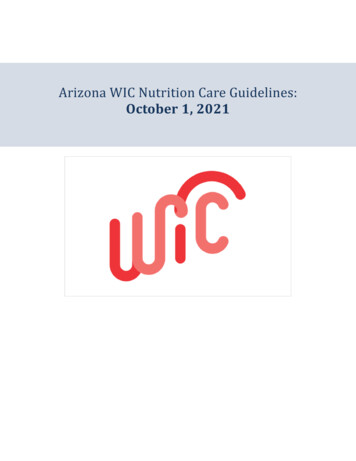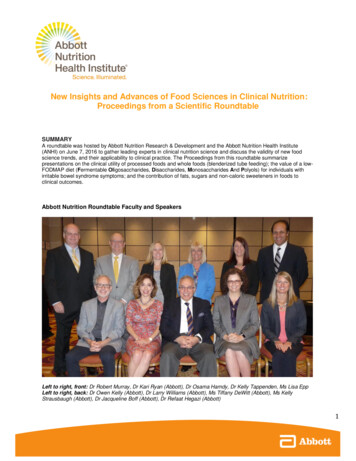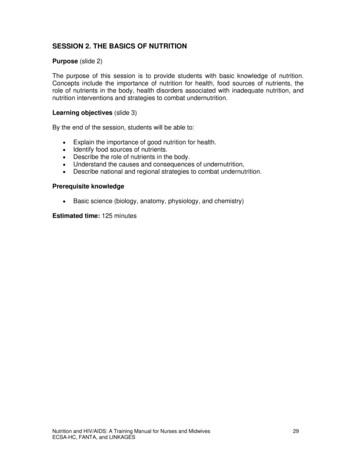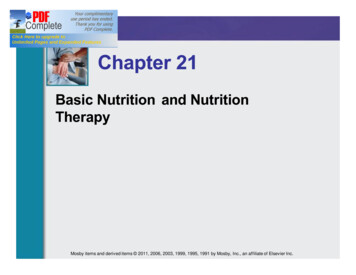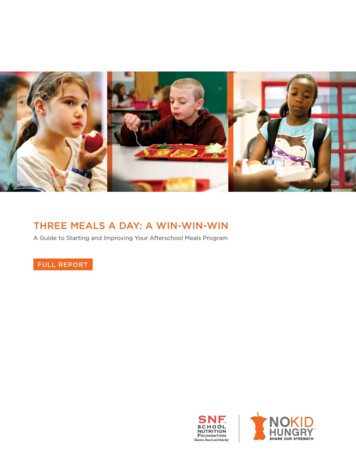
Transcription
ABOUT THIS PUBLICATIONShare Our Strength and the School Nutrition Foundation partnered to learn from school nutrition directors who hadimplemented the Child and Adult Care Food Program’s At-Risk Afterschool Meals Program in their districts. Theinformation, tips, and ideas in this guide are based on interviews conducted with ten school nutrition directors fromacross the country. Each of these directors represented different district characteristics, and each had a uniqueperspective and path to participating in the program.We would like to thank these school nutrition directors for sharing their time and insights:Donna Carver, MEd, SNS, School Nutrition Director, Floyd County Public Schools, GeorgiaAnnette Hendrickx Derouin, MPH, RD, SNS, Director of Food and Nutrition Services, Willmar Public Schools,MinnesotaSharon Glosson, MS, RDN, LD, SNS, Executive Director of School Nutrition Services, North East ISD, TexasLisa Johnson, MS, RD, SNS, Director of Nutrition Services, Highline Public Schools, WashingtonMary Kurkowski, Food and Nutrition Director, Port Huron Schools, MichiganRobert Lewis, PhD, SNS, Director of Nutrition Services, El Monte City School District, CaliforniaDonna S. Martin, EdS, RDN, LD, SNS, FAND, School Nutrition Program Director, Burke County Public Schools,GeorgiaGrace Maschinski, Food Service Director at Aramark, William Floyd Union Free School District, New YorkHelen Phillips, SNS, Senior Director of School Nutrition, Norfolk Public Schools, VirginiaCarolyn Thomas, MBA, SNS, Food Service Consultant, Macomb Intermediate School District, MichiganWe would also like to thank Lynn Harvey, EdD, RDN, LDN, FAND, SNS, State Director at the North CarolinaDepartment of Public Instruction, for providing her insights from the state level.
Three Meals a Day: A Win-Win-WinA Guide to Starting and Improving Your Afterschool Meals Program“Really, it’s a win-win-win: for the schools,for food and nutrition services, and for the kids.”Helen Philips, VirginiaSECTION 1: HOW AFTERSCHOOL MEALS CAN HELP YOUR DISTRICTSchool nutrition directors know that they have to be savvy business operators to run a viable program.But at the heart of the matter, kids need nourishment every day. The Child and Adult Care FoodProgram’s At-Risk Afterschool Meals Program can allow you to do both better than ever.THE NEED1 in 5 kids in America lives in a household without consistent accessto enough food. That’s 15 million children.92%of children from low-income families eat some food after school and before dinner.87%of low-income families purchase food for their children to eat after school instead of getting 400is the median amount of money that low-income families spend per year on food for their59%of low-income families say that it’s hard to provide food for their children to eat after school.125%Usually it’s not all that healthy and often includes chips, cookies, or candy.1meals or snacks from their child’s school or afterschool program.1children to eat after school. The average is over 700 per year.1of low-income families worry that their children don’t have enough to eat between lunch andbreakfast the following day.1“You know that you’re making adifference. When we first started, the[afterschool program] director hadsaid that the behavior, especiallyamong teens, was better. When they’renot hungry, they don’t fight as much.”“It’s the right thing to do for kids -they should have a healthy supper.Snack isn’t enough calories to helpanyone get through afternoon. If bothparents have to work, the kids are oncampus until 5 or 5:30.”Donna Carver, GeorgiaRobert Lewis, CaliforniaNo Kid Hungry Center for Best Practices in partnership with APCO Insights (2014). “National Afterschool Meals Program SurveyFindings.” afterschool-meals-survey-findings.11
OVERVIEW OF THE AFTERSCHOOL MEALS PROGRAMThe Child and Adult Care Food Program (CACFP) is a federal entitlement program that provides fundingto help offset the cost of providing healthy meals and snacks to infants, children, teens, and adults in avariety of care settings, including afterschool programs. Although free snacks have been availablethrough the CACFP and National School Lunch Program (NSLP) for over twenty years, it was not until2010 that educational or enrichment programs in low-income areas across the country became eligible toserve meals (usually suppers) free of charge through the CACFP. This is formally known as the CACFP’sAt-Risk Afterschool Meals component but will be referred to as the Afterschool Meals Program throughoutthis guide. This resource guide will focus on how schools can take advantage of the opportunity to servemeals through the Afterschool Meals Program rather than just snacks through the CACFP or NSLP.Program AdministrationThe CACFP Afterschool Meals Program is administered at the federal level by the U.S. Department ofAgriculture (USDA) and in each state and territory by a designated state agency. The state agency istypically the Department of Education, but in some states, it is the Department of Health, Agriculture, orSocial Services. The CACFP state agency is in the same agency as the NSLP in all but 13 states, buteven when the programs are in the same agency, a separate team usually oversees the CACFP.The CACFP state agency works directly with participating institutions, which may be independent centersor sponsors. Independent centers operate a single program location. A sponsor administers the programat multiple locations, known as facilities.Under a sponsoring organization, there are two possible facility types: Affiliated facilities are part of the same legal entity as the sponsor. A school food authorityadministering the program at schools within the district is a sponsor of affiliated facilities. Unaffiliated facilities do not share the sponsor’s legal or tax identity. A school food authorityadministering the program at locations in the community, like libraries or recreation centers, is asponsor of unaffiliated facilities.A school food authority could sponsor either affiliated or unaffiliated facilities, or both.A non-profit organization could sponsor the Afterschool Meals Program at a school in lieu of its schoolfood authority. The unaffiliated sponsor could manage the program entirely, or it could provideadministrative services only while the school or school food authority provides the meals. The school foodauthority may act as a contracted vendor for the sponsor, providing meals at a fixed per-meal rate, or thesponsor could pass through the reimbursement, less its fee, to offset the school’s foodservice costs.2
Program Eligibility RequirementsEach participating school or community location must: Offer educational or enrichment programming in a structured and supervised environment.A wide variety of activities qualify, from tutoring to band and chess club to mentoring and life skillseducation. The Afterschool Meals Program may not operate for the sole benefit of competitivesports teams, but athletes may receive meals as part of a broader afterschool program that offersactivities for other students. Schools can partner with other organizations to provide the activities. Offer meals free of charge, although they may charge a reasonable fee for the activity. Be within the attendance boundary of an elementary, middle, or high school where at least 50% ofthe students are eligible for free or reduced-price meals.For schools taking advantage of the Community Eligibility Provision (CEP), a school is eligible (orconfers eligibility on other locations within its attendance boundary) if the identified studentpercentage (ISP) multiplied by 1.6 is 50% or higher. Although CEP allows for averages acrossgroupings of schools, this cannot be done to determine Afterschool Meals Program eligibility.Additional details on these requirements can be found in the USDA Afterschool Meals skhandbook.pdf).CURRENT REACHThe number of suppers served through the Afterschool Meals Program has more than quadrupled in thefirst five years that the option has been available nationwide. However, a large gap remains: There areless than four afterschool suppers served for every hundred school lunches going to kids in needacross the country.2 In some states, implementation of the Afterschool Meals Program through CACFPis so low that there are just one or two suppers served for every thousand free or reduced-price lunches.Possible reasons for this gap include: Lack of awareness of the program; Difficulty identifying existing afterschool programs and pairing them with sponsors or vendors; Belief that hunger doesn’t exist within the community, so an afterschool meal is too much foodand may cause obesity; Misconception that the program is only for children in formal, enrolled activities; Perception that it is too difficult to apply or more work than it’s worth; and Transportation challenges.No Kid Hungry Center for Best Practices (2016). “To Meet Need, Growth in Afterschool Snacks and Meals Must Continue: A Report onHistory and Trends.” t/files/resources/afterschool snacks meals history and trends.pdf.23
THE OPPORTUNITYThere is a lot of flexibility to implement the Afterschool Meals Program in a way that works for your districtand the schools and programs you serve. A well-structured program yields numerous benefits for theschools and afterschool programs, your foodservice program, and most importantly, the children reached. For schools and afterschool programs: increasedinterest in tutoring and other programs. For children: better focus and improvedperformance. For your foodservice program:o Increased participation at breakfast andlunch due to the relationship-building thatoccurs in the smaller setting after school.o Opportunity to test new menu items andget feedback from a smaller group.o Additional revenue.The reimbursement rate for a supper is more than threeand a half times the reimbursement for a snack. Allmeals are reimbursed at the free rate, regardless ofindividual children’s eligibility status. Children do noteven have to be enrolled students at the school, muchless formally enrolled in any afterschool activity.Schools that have implemented the Afterschool MealsProgram report that the reimbursements cover basiccosts. Sometimes, there are enough funds to pay foradditional equipment purchases. Directors are able togive extra hours or overtime desired by employees, andin some cases, even create additional positions.The tips and ideas in the following sections draw on theexperience of the ten school nutrition directorsinterviewed for this project.“The afterschool enrichmentcoordinator was hoping for 30 kidsin the tutoring program, but withthe meal and word-of-mouthpromotion, there are now 150 kidsparticipating in the meal.”Annette Derouin, Minnesota“This is an essential program in ourdistrict. The kids are willing to stayafter school for tutoring because ofthe hot meal. The graduation ratehas increased, and the athletes aregaining weight and muscle andperforming better.”Donna Martin, Georgia“The smaller group at dinner helpsthe students get to know thestaff The high school kitchenmanager said that kids who got toknow her at dinner call her grandmanow, and they come in for lunch,when they never did before.”Helen Philips, Virginia4
SECTION 2: LAY THE GROUNDWORKLEARN THE BASICS Call your state agency to learn about the training and application process in your state.The NSLP staff should be able to point you to the person who handles the Afterschool MealsProgram specifically or all new applicants for the CACFP. Understand the requirements.The USDA Afterschool Meals handbook ok.pdf)is an easy-to-read guide to the Afterschool Meals Program. Contact another district, ideally within your state, to learn how they implemented the program.ASSESS THE NEED AND INTEREST IN SCHOOLS ACROSS THE DISTRICT Consider the free or reduced-price meal eligibility“It’s been wonderful. Evenpercentage and current snack participation, if applicable.in a district that’s 45 percentEven if the district’s average free or reduced-pricefree or reduced-priceeligibility is under 50 percent, there may be several higheligible, there are still kidsneed schools where many students would benefit from thewho need this after school.”meal. An individual school under the 50 percent free orSharon Glosson, Texasreduced-price threshold may still be a great candidate aswell, especially if there’s a robust afterschool enrichment program. A school is eligible as long as itis within the attendance boundary of a school that meets the 50 percent threshold. Survey schools to learn what afterschool activities are already happening and get a sense of theirdaily and annual schedules as well as the number of kids they typically serve. This can includeboth school-sponsored activities as well as third-party or independent programs that operate in theschool building. As afterschool programming providers, 21st Century Community Learning Centergrantees are great partners. Assess the schools’ ability to offer additional low-barrier activities like tutoring or recreational sportsthat may draw more students to stay for the meal. Having a drop-in activity available to all may alsohelp to build support for an actively promoted, open-to-all meal program. Teacher contracts orunions may limit teachers’ ability to stay for afterschool programming, but volunteer groups oroutside organizations may be able to do this. Investigate transportation options. A school with many walkers or bikers who can decide when toleave could have higher participation. It could be difficult to change bus schedules, especially midyear, but the departure time for regular or later “activity” buses could be pushed back. Enhancingthe logistics of loading buses could also provide enough time for a meal served right after the bell.“It was nice to work with schools where something is already happening [afterschool]. Since we got our foot in the door with one program operating at multipleschools, it was easy.”Lisa Johnson, Washington5
ASSESS INTERNAL FACTORSTake into account circumstances like: The current staffing model and bandwidth to handle additional work, The minimum wage in your area, The cost of benefits for new employees or employees moving from part-time to full-time, Overtime costs, Union restrictions, Procurement and bidding processes, Current kitchen equipment availability and usage, and Storage capacity of individual facilities and/or central kitchens.Different preparation or staffing models may work for you based on these circumstances. Grants can helpovercome start-up costs, like additional milk coolers.3 The meal reimbursements from the AfterschoolMeals Program may cover the cost of gradual expansion or improvements to equipment.ENGAGE KEY STAKEHOLDERSPartnerships are key to having optimal implementation and the highest possible participation. The schoolnutrition directors interviewed said that they valued having a variety of people on board, including: The superintendent, School principals, Afterschool activity coordinators, Athletic directors and coaches, Custodial staff, and School nutrition staff.Unless you’re considering Supper in the Classroom, this is a similar but often different set of stakeholdersthan for Breakfast After the Bell models. Everyone who would be impacted should be involved early in theplanning process to build investment and talk through challenges. Naysayers could be connected withsuccessful districts to address their concerns.“Check with all of your key stakeholders, especially the principal, custodian, andteachers who are there after school. They need to be informed, and they need to beinvolved in developing standard operating procedures. You have be a part of teambefore getting started. For long term success it’s important to work collaboratively.”Robert Lewis, California3See ion-program-grant-opportunities for information on funding opportunities.6
SECTION 3: PLAN FOR IMPLEMENTATION IN YOUR DISTRICT“Make sure systems are in place. Without pre-planning, you could set yourself up forfailure. You need to have the planning piece and then roll with it,making changes as needed.”Carolyn Thomas, MichiganSPONSORSHIP OPTIONS Sponsor schools within your school food authority.Keeping operation of the program within the district likely requires the fewest logisticalconsiderations and partnerships since most if not all stakeholders are under the same leadership. Sponsor both schools and community sites.Serving additional meals at community sites could help you to reach financial viability or save forequipment upgrades by spreading out labor and overhead costs over more meals. This could beespecially helpful if community-based organizations like the YMCA or Boys and Girls Clubs havemore robust afterschool programs than the schools. Enter into an agreement with an outside sponsor who handles the administration.The sponsor is responsible for the administration and oversight of the Afterschool Meals Program.You could either receive part of the meal reimbursement (at least 85 percent) in exchange forproviding meals, or contract with the sponsor to provide meals at a fixed per-meal rate.The sponsor could be an experienced CACFP sponsoring organization. Or, an afterschool programthat operates at one or more schools, like a 21st Century Community Learning Center grantee,could take on the role.MENU APPROACH Meal pattern.o Schools have the option to follow either the NSLP or CACFP meal pattern. While manyconsider the CACFP meal pattern to be easier and more flexible, some school nutritiondirectors prefer to use the NSLP meal pattern all the time to reduce confusion for staffmembers who plan or prepare both lunch and supper.o Schools also have the option to implement Offer Versus Serve (OVS). This can provideflexibility to students and reduce food waste. However, this is more complex to implement. Unitized or bulk meals.o The school nutrition directors interviewed were fairly split on favoring unitized orbagged/boxed meals versus a serving line.o A few school nutrition directors did both, depending on the school or the day of the week.Some offered unitized meals for field trips.7
Cold or hot meals.o Some of the school nutrition directors interviewed indicated that there was more interest withhot meals over all-cold meals.o Other school nutrition directors indicated that constraints like high labor costs or reliance onafterschool program staff to distribute meals necessitated all-cold meals.o Cold meals are typically easier to prepare earlier in the day and hold until service time. Thiscan also provide more flexibility for a long serving time, multiple shifts, or a variety of servinglocations. A cold “super snack” is a good option for schools where the need or interest is lower,or it is not feasible to serve hot meals. A “super snack” meets the supper meal pattern requirements, so it is eligible for thefull supper reimbursement, but it includes minimum portion sizes of snack-like itemsfor each component. As an example, this could be a string cheese stick, hummus,baby carrots, grapes, pita chips, and milk.o Offering hot meals Monday through Thursday and a cold meal on Friday can provide thevariety and interest associated with hot meals while minimizing the potential waste whenFriday participation is lower or less predictable. Menu options.o Few of the school nutrition directors interviewed provide multiple food options for theafterschool meal. It was more common to offer a choice of fruits and vegetables than anentrée choice.o Leftovers from lunch can be used to increase the variety of options at supper. Some schoolnutrition directors indicated that students preferred to eat their favorite item at lunch andsupper, so they wanted that option.o Leftovers from supper can be offered on the line the next day at lunch to minimize waste.MEAL PREPARATION CONSIDERATIONS Meal preparation location.o Based on the current model for preparing breakfast and lunch as well as the availableinfrastructure, meals could be prepared at a central location or on-site at each participatingschool.o Depending on the size of the program at each school, it could be more efficient to have staffat one location prepare all of the meals and deliver them to each school. A single staffmember could deliver meals to each location for distribution by volunteers or afterschoolprogram staff, or the school nutrition staff could bring meals to a school and then stay toserve them.o Arranging for milk deliveries directly to each participating location may be an option thatreduces the work of counting and delivering milk from the central kitchen.8
Storage space and equipment.o Regardless of the menu approach selected, more storage space will be needed; exactly howmuch depends on expected participation.o More frequent milk deliveries or direct deliveries to each participating location can mitigatethe need for additional milk coolers.o Additional hotel pans and other cooking equipment may be needed if supper preparationstarts before lunch service has ended. Staffing levels.o The staff time required can vary dramatically based on your program’s goals and expectedparticipation. It can be very low depending on the menu approach. Maximizing efficiencieswith lunch preparation and centralized production could also reduce the staff time needed.o Three school nutrition directors said that when preparation is split among employees, thesupper requires 30 minutes or less of labor. Two of those districts, and some schools withinthe third, have not had to add any hours to employees’ days.o Most of the school nutrition directors interviewed needed additional staff time to operate theprogram, and most preferred to give additional hours or overtime pay to existing employeesrather than hire and provide benefits for new employees. However, a few said that revenuefrom the program allowed them to hire new staff or convert staff from part-time to full-time.DAILY LOGISTICS Meal distribution.o Relying on volunteers or afterschool programstaff for meal distribution can be a great option toreduce labor costs. This tends to be mostfeasible when the meals are cold and/or unitizedso that they do not require as much expertise todistribute and count.o If schools wish to provide hot meals, the option ofOVS, or more menu choices, experienced schoolnutrition staff may be needed to serve meals. Ifthese options lead to higher participation, thebenefits may outweigh the added labor costs. Daily schedule.o Depending on the number of afterschool activities occurring at each school and theirschedules, a long meal service or multiple shifts may be needed to maximize participation.o For schools relying on school nutrition staff to distribute meals, it is most cost effective towork with the afterschool programs to adjust their activity schedules so that students havetime for the meal soon after the final bell. However, some districts have a separate staffmember prepare and serve supper, which provides more flexibility on serving time.9
Record keeping.o Discussing planned procedures with the state agency in advance is strongly recommended.o USDA guidance, including the handbook, specify that although dated, daily attendance is arequired record, there is no requirement to have enrollment records or track the activity inwhich children participate, if any. In fact, the USDA explicitly states that children do not haveto participate in any offered activity in order to receive a meal. The attendance does need toreflect all students who receive a meal, though, not just activity participants.o There are a variety of different systems that can work for taking attendance and mealcounts: some use electronic point-of-sale systems while others use paper sign-in sheets orrosters along with meal check-off sheets. An electronic system, like a PIN number or swipe card system, could be an efficientway to collect and calculate attendance as long as there is a way to also record themeal count. Drop-in programs open to non-students may not be able to use anelectronic system if they do not allow non-enrolled children to be entered. One school issues each student a poker chip after signing in; kids use the poker chipto get the meal, and then the school uses the chip count for the meal count.o Many school nutrition directors rely on afterschool program staff to take attendance andmeal counts. However, some found that it is too difficult to rely on them to complete therecords consistently and accurately. Since poor record keeping jeopardizes reimbursements,those directors have their own school nutrition staff maintain the records.o If the school nutrition staff does not have the capacity to handle the additional recordkeeping, filing, and claim preparation, seeking out a sponsor could be a viable option.STARTING OUT Pilot phase.Especially if stakeholders are skeptical, a finite pilotperiod can help you to build a case for the programwhile developing the implementation plan. Roll-out.Several school nutrition directors reported that rollingout the program school by school over several weeksor months was useful to assess interest, improvelogistics, and test menu items. Others who started at alleligible schools at once wished they had gone slower.“Start with one site to learnhow it’s working and fine tuneit, especially if that site has anadvocate and will give honestfeedback. Plus, an advocatewill help with promotion laterduring roll-out so it’s not justcoming from the food andnutrition director.”Sharon Glosson, Texas“Do it! The application is cumbersome, but don’t let it stop you from doing a programthat benefits students; think about helping students to be successful.And the second year was a lot easier.”Annette Derouin, Minnesota10
SECTION 4: MAKE IT BETTERPROMOTE THE PROGRAM Expand afterschool meals to additional afterschool programs and schools.o Attend or present at meetings with principals, afterschool program coordinators, coaches,and athletic directors to make them aware of the program, explain the benefits, and helpthem to build it into their schedules.o Build interest by sharing data about the need as well as success stories from nearby districtsor from pilots within your district. Advertise the meals to students, parents, and the community.o Consider making periodic all-school announcements via the public address system to ensurethat all students are aware of the program.o Utilize the school’s or food service program’s social media outlets to promote the meal.o Post menus and meal times on the school website or send flyers home to inform parents.ENHANCE THE PROGRAM Facilitate ongoing communication between key stakeholders.o Have a shared calendar or system for communicating schedule updates. Communication should involve school administrators as well as afterschool programstaff and coaches. Common reasons for participation fluctuation that school nutritiondirectors cited include: early dismissals and half days, intensive periods of testpreparation, and transition times in between sports’ seasons. Field trips and away games may cause participation to dip, but with advance planningand approval, bagged or boxed meals could be taken off-site.o Host regular meetings between afterschool program leaders, administration, and schoolnutrition staff to continue addressing challenges and needs.“Working with different groups, sometimes it’s frustrating for my staff and theafterschool staff [ ] so that’s why we meet once a month and keep open lines ofcommunication. It’s gotten a lot better.”Mary Kurkowski, Michigan Tweak the menu in response to performance, surveys, and taste tests.o One school nutrition director asked the students what they wanted to eat after school, andstudents said that they liked the food at Starbucks. After looking at the various snack packoptions there, the schools began offering bento box suppers: snack items for each mealcomponent, packaged in an appealing orange container with a clear lid.o Another school nutrition director discovered that entrée salads took students too long to eatwhen they were trying to rush off to their activities, so those were taken off the supper menu.11
Have shelf-stable meal options available to deal with unexpected participation, or hedge when aprogram coordinator requests for large number of meals for a new program. Consider innovative serving models to boost participation.o The Umbrella Model: Under the “umbrella” of afterschool programming that includes avariety of activities available to the student body, the availability of the afterschool meal canbe actively promoted to all students. In pilot tests conducted by Share Our Strength, schoolsthat implemented the Umbrella Model and advertised the afterschool meal increasedparticipation by a median of 53% over historic participation levels.o Supper in the Classroom: Just like breakfast, supper can be served or eaten in theclassroom. This can be easier for elementary school students who may have less controlover their afterschool hours. In schools that tested this model for Share Our Strength,participation skyrocketed to higher levels than lunch.“School nutrition professionals areunderstanding that they arethe community-based championsfor the children.It’s not a question of ‘will it work?’but ‘how can we make it work?’because the need is there.”“[Doing this program] gives you a lot ofkudos and recognition within thedistrict — coaches like you, principalslike you. Sometimes the food andnutrition director is not the most-likedor well-regarded person, but by doingsupper, you get a lot of capital.”Carolyn Thomas, MichiganDonna Martin, Georgia“It’s absolutely
The CACFP state agency is in the same agency as the NSLP in all but 13 states, but even when the programs are in the same agency, a separate team usually oversees the CACFP. The CACFP state agency works directly with participating institutions, which may be independent centers or sponsors. Independent centers operate a single program location.




